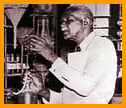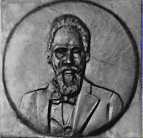Some Inventions Made by Black People
- air conditioning unit: Frederick M. Jones; July 12, 1949
- almanac: Benjamin Banneker; Approx 1791
- auto cut-off switch: Granville T. Woods; January 1,1839
- auto fishing devise: G. Cook; May 30, 1899
- automatic gear shift: Richard Spikes; February 28, 1932
- baby buggy: W.H. Richardson; June 18, 1899
- bicycle frame: L.R. Johnson; Octber 10, 1899
- biscuit cutter: A.P. Ashbourne; November 30, 1875
- blood plasma bag: Charles Drew; Approx. 1945
- cellular phone: Henry T. Sampson; July 6, 1971
- chamber commode: T. Elkins; January 3, 1897
- clothes dryer: G. T. Sampson; June 6, 1862
- curtain rod: S. R. Scratton; November 30, 1889
- curtain rod support: William S. Grant; August 4, 1896
- door knob: O. Dorsey; December 10, 1878
- door stop: O. Dorsey; December 10, 1878
- dust pan: Lawrence P. Ray; August 3, 1897
- egg beater: Willie Johnson; February 5, 1884
- electric lampbulb: Lewis Latimer; March 21, 1882
- elevator: Alexander Miles; October 11, 1867
- eye protector: P. Johnson; November 2, 1880
- fire escape ladder: J. W. Winters; May 7, 1878
- fire extinguisher: T. Marshall; October 26, 1872
- folding bed: L. C. Bailey; July 18, 1899
- folding chair: Brody & Surgwar; June 11, 1889
- fountain pen: W. B. Purvis; January 7, 1890
- furniture caster: O. A. Fisher; 1878
- gas mask: Garrett Morgan; October 13, 1914
- golf tee: T. Grant; December 12, 1899
- guitar: Robert F. Flemming, Jr. March 3, 1886
- hair brush: Lydia O. Newman; November 15,18--
- hand stamp: Walter B. Purvis; February 27, 1883
- horse shoe: J. Ricks; March 30, 1885
- ice cream scooper: A. L. Cralle; February 2, 1897
- improv. sugar making: Norbet Rillieux; December 10, 1846
- insect-destroyer gun: A. C. Richard; February 28, 1899
- ironing board: Sarah Boone; December 30, 1887
- key chain: F. J. Loudin; January 9, 1894
- lantern: Michael C. Harvey; August 19, 1884
- lawn mower: L. A. Burr; May 19, 1889
- lawn sprinkler: J. W. Smith; May 4, 1897
- lemon squeezer: J. Thomas White; December 8, 1893
- lock: W. A. Martin; July 23, 18--
- lubricating cup: Ellijah McCoy; November 15, 1895
- lunch pail: James Robinson; 1887
- mail box: Paul L. Downing; October 27, 1891
- mop: Thomas W. Stewart; June 11, 1893
- motor: Frederick M. Jones; June 27, 1939
- peanut butter: George Washington Carver; 1896
- pencil sharpener: J. L. Love; November 23, 1897
- record player arm: Joseph Hunger Dickenson January 8, 1819
- refrigerator: J. Standard; June 14, 1891
- riding saddles: W. D. Davis; October 6, 1895
- rolling pin: John W. Reed; 1864
- shampoo headrest: C. O. Bailiff; October 11, 1898
- spark plug: Edmond Berger; February 2, 1839
- stethoscope: Imhotep; Ancient Egypt
- stove: T. A. Carrington; July 25, 1876
- straightening comb: Madam C. J. Walker; Approx 1905
- street sweeper: Charles B. Brooks; March 17, 1890
- phone transmitter: Granville T. Woods; December 2, 1884
- thermostat control: Frederick M. Jones; February 23, 1960
- traffic light: Garrett Morgan; November 20, 1923
- tricycle: M. A. Cherry; May 6, 1886
- typewriter: Burridge & Marshman; April 7, 1885
A Sampling of African-American Inventors and Their Inventions
| BLOOD BANK The idea of a blood bank was pioneered by Dr. Charles Richard Drew (1904-1950). Dr. Drew was an American medical doctor and surgeon who started the idea of a blood bank and a system for the long term preservation of blood plasma (he found that plasma kept longer than whole blood). His ideas revolutionized the medical profession and saved many, many lives. Dr. Drew set up and operated the blood plasma bank at the Presbyterian Hospital in New York City, NY. Drew's project was the model for the Red Cross' system of blood banks, of which he became the first director. |
CARVER, GEORGE WASHINGTON George Washington Carver (1865?-1943) was an American scientist, educator, humanitarian, and former slave. Carver developed hundreds of products from peanuts, sweet potatoes, pecans, and soybeans; his discoveries greatly improved the agricultural output and the health of Southern farmers. Before this, the only main crop in the South was cotton. The products that Carver invented included a rubber substitute, adhesives, foodstuffs, dyes, pigments, and many other products. George Washington Carver (1865?-1943) was an American scientist, educator, humanitarian, and former slave. Carver developed hundreds of products from peanuts, sweet potatoes, pecans, and soybeans; his discoveries greatly improved the agricultural output and the health of Southern farmers. Before this, the only main crop in the South was cotton. The products that Carver invented included a rubber substitute, adhesives, foodstuffs, dyes, pigments, and many other products.For more information on Carver, click here. For a cloze (fill-in-the-blank) activity on Carver, click here. |
| CRUM, GEORGE The potato chip was invented in 1853 by George Crum. Crum was a Native American/African American chef at the Moon Lake Lodge resort in Saratoga Springs, New York, USA. French fries were popular at the restaurant and one day a diner complained that the fries were too thick. Although Crum made a thinner batch, the customer was still unsatisfied. Crum finally made fries that were too thin to eat with a fork, hoping to annoy the extremely fussy customer. The customer, surprisingly enough, was happy - and potato chips were invented! For more information on George Crum and potato chips, click here. |
| DREW, CHARLES RICHARD |
| GAS MASK The gas mask was invented by Garrett Morgan, an African-American inventor. Morgan used his gas mask (patent No. 1,090,936, 1914) to rescue miners who were trapped underground in a noxious mine. Soon after, Morgan was asked to produce gas masks for the US Army. For more information on Garrett Morgan, click here. |
| LATIMER, LEWIS H. For more information on Lewis Howard Latimer, click here. |
| McCOY, ELIJAH For more information on Elijah McCoy, click here. For a cloze activity on McCoy, click here. |
MORGAN, GARRETT Garrett Augustus Morgan (March 4, 1877 - August 27, 1963), was an African-American inventor and businessman. He was the first person to patent a traffic signal. He also developed the gas mask (and many other inventions). Morgan used his gas mask (patent No. 1,090,936, 1914) to rescue miners who were trapped underground in a noxious mine. Soon after, Morgan was asked to produce gas masks for the US Army. Garrett Augustus Morgan (March 4, 1877 - August 27, 1963), was an African-American inventor and businessman. He was the first person to patent a traffic signal. He also developed the gas mask (and many other inventions). Morgan used his gas mask (patent No. 1,090,936, 1914) to rescue miners who were trapped underground in a noxious mine. Soon after, Morgan was asked to produce gas masks for the US Army.For more information on Morgan, click here. |
| POTATO CHIPS The potato chip was invented in 1853 by George Crum. Crum was a Native American/African American chef at the Moon Lake Lodge resort in Saratoga Springs, New York, USA. French fries were popular at the restaurant and one day a diner complained that the fries were too thick. Although Crum made a thinner batch, the customer was still unsatisfied. Crum finally made fries that were too thin to eat with a fork, hoping to annoy the extremely fussy customer. The customer, surprisingly enough, was happy - and potato chips were invented! For more information on George Crum and potato chips, click here. |
TRAFFIC SIGNAL Garrett Augustus Morgan (March 4, 1877 - August 27, 1963), was an African-American inventor and businessman. He was the first person to patent a traffic signal. He also developed the gas mask (and many other inventions). Morgan used his gas mask (patent No. 1,090,936, 1914) to rescue miners who were trapped underground in a noxious mine. Soon after, Morgan was asked to produce gas masks for the US Army. Garrett Augustus Morgan (March 4, 1877 - August 27, 1963), was an African-American inventor and businessman. He was the first person to patent a traffic signal. He also developed the gas mask (and many other inventions). Morgan used his gas mask (patent No. 1,090,936, 1914) to rescue miners who were trapped underground in a noxious mine. Soon after, Morgan was asked to produce gas masks for the US Army.For more information on Morgan, click here. |
Comment
© 2025 Created by Lucinda F. Boyd.
Powered by
![]()
 Norbert Rillieux (March 17, 1806-October 8, 1894) was an African-American inventor and engineer who invented a device that revolutionized sugar processing. Rillieux's multiple effect vacuum sugar evaporator (patented in 1864) made the processing of sugar more efficient, faster, and much safer. The resulting sugar was also superior. His apparatus was eventually adopted by sugar processing plants all around the world.
Norbert Rillieux (March 17, 1806-October 8, 1894) was an African-American inventor and engineer who invented a device that revolutionized sugar processing. Rillieux's multiple effect vacuum sugar evaporator (patented in 1864) made the processing of sugar more efficient, faster, and much safer. The resulting sugar was also superior. His apparatus was eventually adopted by sugar processing plants all around the world. Madam C. J. Walker (December 23, 1867 - May 25, 1919) was an inventor, businesswoman and self-made millionaire. Sarah Breedlove McWilliams C. J. Walker was an African-American who developed many beauty and hair care products that were extremely popular. Madam Walker started her cosmetics business in 1905. Her first product was a scalp treatment that used petrolatum and sulphur. She added Madam to her name and began selling her new "Walker System" door-to-door. Walker soon added new cosmetic products to her line. The products were very successful and she soon had many saleswomen, called "Walker Agents," who sold her products door to door and to beauty salons.
Madam C. J. Walker (December 23, 1867 - May 25, 1919) was an inventor, businesswoman and self-made millionaire. Sarah Breedlove McWilliams C. J. Walker was an African-American who developed many beauty and hair care products that were extremely popular. Madam Walker started her cosmetics business in 1905. Her first product was a scalp treatment that used petrolatum and sulphur. She added Madam to her name and began selling her new "Walker System" door-to-door. Walker soon added new cosmetic products to her line. The products were very successful and she soon had many saleswomen, called "Walker Agents," who sold her products door to door and to beauty salons.
You need to be a member of THE STREETS DON'T LOVE YOU BACK to add comments!
Join THE STREETS DON'T LOVE YOU BACK